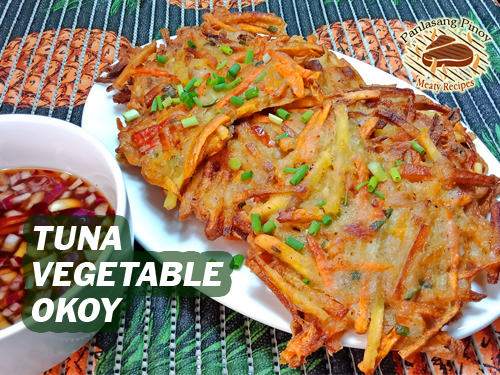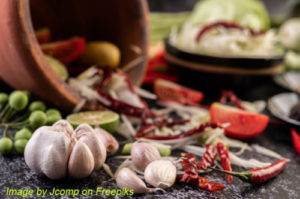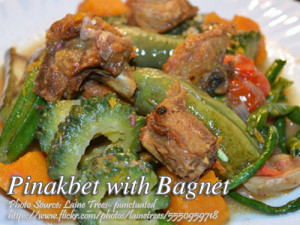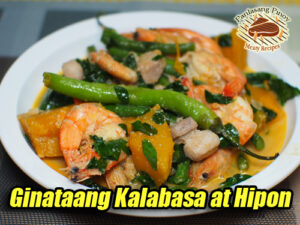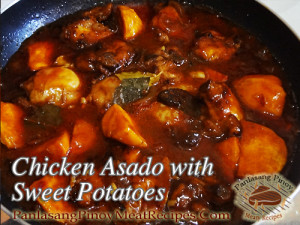A tasty and healthy tuna vegetable okoy made from tuna chunks and combination of vegetables such as squash, carrots, sweet potatoes (or kamote). This appetizer is very suited to picky eaters like kids who doesn’t want to eat fish or vegetables. You can give them a chance to eat vegetables in a different way that is crisp and tasty. And also, I have a tasty sweet and tangy vinegar dipping sauce which I’m sure you will love!!!
Tuna Vegetable Okoy: A Crispy Classic With a Modern Twist
I still remember the first time I had okoy. It was at my Lola Mercy’s house in Tarlac, during one of those long summer breaks when cousins would sleep over, and merienda was the highlight of the day. Her version was the traditional one—shredded kalabasa, tiny shrimps, and just enough batter to hold everything together before it hit the sizzling oil. Golden, crunchy, and perfect with suka. But years later, my cousin Jeric, who now works as a home cook in Cavite, introduced me to a healthier version he made for his kids: tuna vegetable okoy.
Why This Tuna Okoy Version Works
Let’s face it: kids can be picky eaters, especially when vegetables or fish are involved. Jeric’s trick? Sneak both into a crispy, golden fritter no child (or adult) can resist. The combination of flaked tuna and colorful veggies like carrots, squash, and sweet potato not only gives great flavor and texture, but it also adds nutrients that would otherwise be pushed aside on a dinner plate.
The batter, made from flour, cornstarch, and egg, plays a crucial role. The cornstarch gives it that essential crunch, while the egg and flour bind everything together without making it too doughy. Add a touch of salt and pepper, and the flavor profile stays light, letting the veggies and tuna shine through.
How to Make Tuna Vegetable Okoy at Home
Start with a can of good-quality tuna in oil or water. Drain it well and flake it using a fork—you want those soft, meaty pieces to mix evenly. Then, grate your vegetables: I like a mix of kalabasa, carrots, and kamote. Bell peppers give an extra pop of color and sweetness, and chopped garlic, onions, and spring onions round out the flavor.
The key here is to make sure your batter is smooth. Mix the flour, cornstarch, water, and egg until there are no lumps. Then toss in the veggies and tuna and mix until everything is coated. When frying, use a ladle to shape your patties so they cook evenly and don’t crowd the pan. Each fritter should sizzle as it hits the hot oil—that’s how you know it’ll come out crispy.
The Perfect Partner: Sweet and Tangy Vinegar Dip
What elevates this tuna okoy even more is the dipping sauce. It’s a simple mix of vinegar, a bit of sugar, chopped garlic, chili, and a pinch of salt. The tanginess cuts through the richness of the fried fritters, while the hint of sweetness rounds out the sharpness. It’s a dipping sauce you’ll find in many Filipino kitchens and works beautifully here.
Okoy Through the Years: A Brief History
Originally thought to have roots in Chinese-Filipino cuisine, okoy (or ukoy) has long been a staple street food and home-style snack across the Philippines. The traditional version features small shrimp and kalabasa, but over time, home cooks began experimenting with local and affordable ingredients like mung bean sprouts, tofu, or even canned tuna. It’s a dish that reflects Filipino creativity and resourcefulness—always evolving but still deeply comforting.
Why This Dish Deserves a Spot on Your Table
Whether you’re trying to introduce more veggies into your family’s meals, or you just want a nostalgic snack with a healthy twist, tuna vegetable okoy is a winner. It’s affordable, quick to make, and incredibly satisfying. I like serving it on lazy Sunday afternoons, usually with a big bowl of sinamak on the side and a glass of cold calamansi juice. It’s a taste of home that never fails to bring back good memories.
Try it for your next merienda or even as a ulam paired with rice. You might just start a new family tradition.
How to Cook Tuna Vegetable Okoy
Ingredients
- 1 medium can tuna chunks in oil or in water drained and flaked
- 250 grams sweet potato kamote, cut into strips
- 250 grams squash cut into strips
- 1 cup all-purpose flour
- 1 cup cornstarch
- 1 medium size carrot cut into strips
- 1 pc bell pepper chopped
- 1 1/2 cups water
- 1 pc medium onion chopped
- 2 cloves garlic minced
- 1 Tbsp. spring onions chopped
- 1 pc egg beaten
- 1/2 tsp. salt
- 1/2 tsp. pepper
- cooking oil for frying
Vinegar Dipping Sauce:
- 1/2 cup cane vinegar or white vinegar
- 1 Tbsp sugar
- 1/2 tsp salt
- 1/4 tsp. pepper
- 1 tsp. soy sauce.
- 1 Tbsp. chopped onion
- 2 cloves garlic minced
Instructions
How to Cook Tuna Vegetable Okoy
- In a mixing bowl, combine flour, cornstarch, egg, water, salt and pepper. Mix until the batter is smooth and all the lumps disappear.
- Drain the tuna chunks and flake it using a fork or spoon.
- Then in the mixing bowl add the carrot, squash, sweet potato, bell pepper, tuna chunks, garlic, onion and spring onions.
- Mix the ingredients thoroughly until the veggies are well coated with the batter.
- Heat cooking oil in a frying pan about an inch deep. When oil is hot enough, scoop the okoy mixture using a small laddle and pour in the frying pan and shape it like a patty.
- Make 2 to 3 patties on each batch and avoid them sticking on each other. Fry the patties until golden brown on each sides, top and bottom.
- Then transfer to a paper towel lined plate and serve with vinegar dipping sauce (see recipe below).
How to make vinegar dipping sauce:
- Mix all the dipping sauce ingredients in a bowl until the sugar is dissolved.
Video
Notes
Cooking Tips:
Drain the Tuna Well
Before mixing the tuna into your batter, make sure to drain it thoroughly to avoid excess moisture. Too much liquid can make the batter soggy and cause the fritters to fall apart during frying. Flaking the tuna evenly also helps distribute the flavor in every bite.Grate Vegetables Thinly and Evenly
For a light and crispy texture, grate the vegetables into thin, uniform strips. This ensures they cook quickly and blend well into the batter, giving a balanced crunch in every piece. Uneven chunks can lead to raw spots or soggy centers.Fry in Small Batches Over Medium-High Heat
Avoid overcrowding the pan to maintain the oil’s temperature and ensure even browning. Frying at medium-high heat helps the patties crisp up on the outside while cooking through on the inside. Let each batch rest on paper towels to drain excess oil and keep them crisp.
